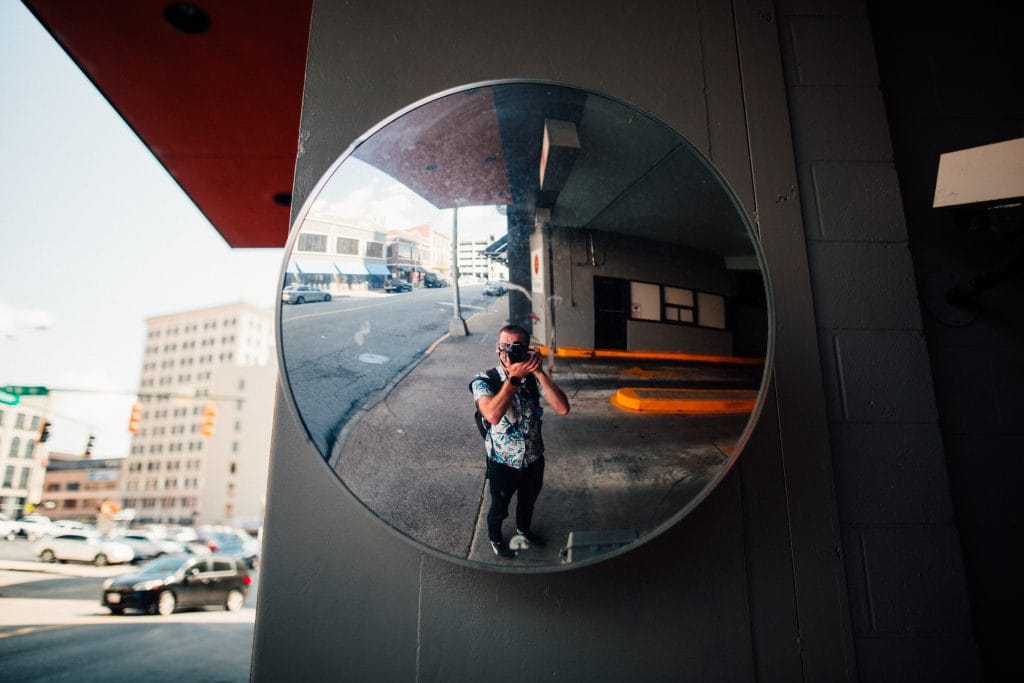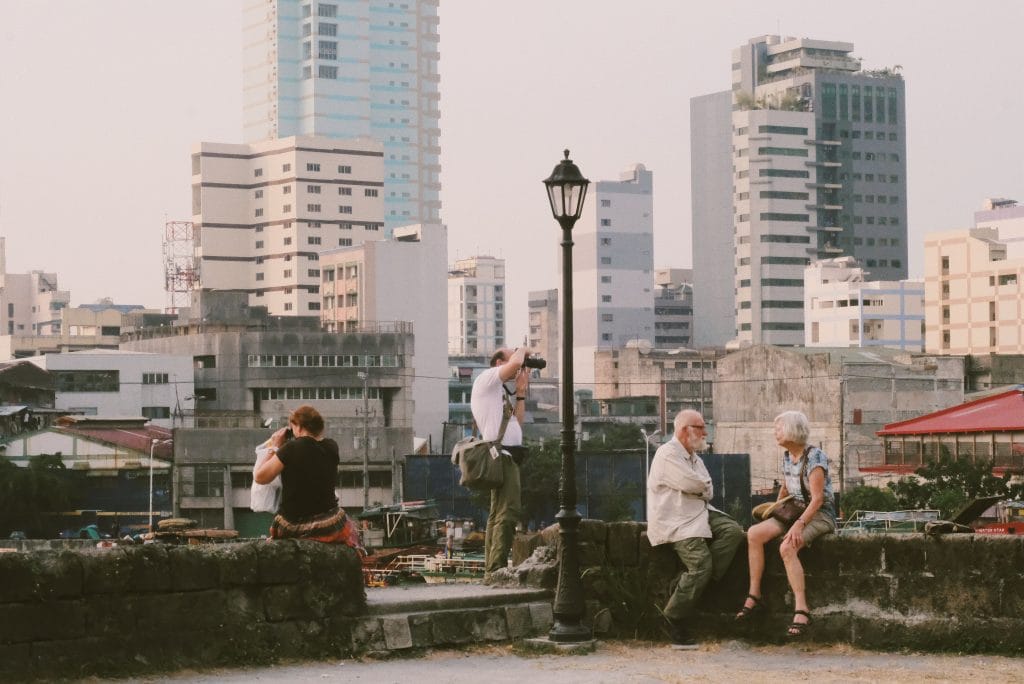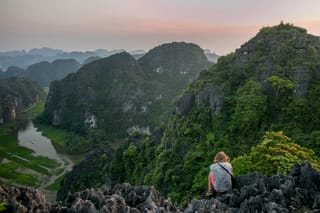
Have you ever meandered around a bustling city street and experienced new sights, sounds, smells, and experiences just waiting to be captured? Then you’ve enjoyed the first piece of street photography: the experience. The second piece is documenting the experience to share with others.
Street photography is a fascinating form of photography that captures the authentic moments of everyday life in urban environments and public places. While the concept may seem as simple as taking photos on busy sidewalks, it’s not always easy trying to capture the heart of a place in photos.
In this article, we will share our favorite tips and tricks to help you either get started in street photography or take your skills to the next level. Our tips include:
- Getting the right equipment
- Understanding your camera settings
- Trying aperture priority mode
- Patience to get the right shots
- Capturing the “Decisive Moment”
- Learning the best rules for composition
- Experimenting with different lighting techniques
- Photographing local everyday life
- Trying different types of street photography
- Showing respect when photographing people
- Continuing to hone your skills through education
What is Street Photography?

Street photography is a genre of photography that records everyday life in public places. It makes capturing fleeting moments of everyday life a moving art form.
Elements of this genre include rawness, authenticity, patience, and community. There is a uniquely human element to it that makes it relatable and accessible to both the photographer and the audience.
Henri Cartier-Bresson is credited with being the father of street photography in the 1930s, although there are earlier accounts of people working in this style as early as the 1890s. Still, Cartier-Bresson is one of the earliest photographers to make meaningful strides in bringing this photography to the forefront of art.
Evolution of this style

Street photography, like many photography mediums, has evolved over time to grow and advance with an ever-changing digital world. One of the biggest changes to affect this specific style is the smartphone and social media, which allow people to easily and immediately capture and share a moment in time.
Many professional photographers tout street photography as one of the most rewarding genres as it allows them to capture an ordinary moment and freeze it in time as something extraordinary.
Types of Street Photography
This genre of photography does not include just one type of photo. THe different types of photography included in the broader term “street photography” include:
- Street fashion photography
- Street portrait photography
- Urban street photography
- Night street photography
- Street art photography
- Film street photography
11 Street Photography Tips
Now that we’ve set the stage for what street photography is and how it has grown and changed, here is a list of expert tips to help you get started in this field.
1. Get the Right Equipment
Choosing the right gear is essential to being able to document the experience in a manner that does a place justice.

Cameras
Unlike some forms of photography that may require lots of heavy gear, street photography is all about minimalism. You should be able to blend in with your surroundings and carry around your camera for long stretches of time.
We recommend compact cameras that are light and portable for all your adventures. Mirrorless and 35mm film cameras in particular are great because of their portability.
Whether you decide to choose a film or digital camera for street photography is generally based on your preference and the overall aesthetic you want to achieve. If you pick one with a good sensor and favor shorter focal lengths, digital cameras can create sharper, more detailed images with incredible depth of field, while 35mm film cameras will create a grainier, more timeless look that can completely change the feel of the image.
Mirrorless cameras are especially popular because of their portability and high-tech features like subject detection autofocus tracking and continuous shooting at high fps. Many also offer the ability to shoot 4k video as another way to document fast-moving scenes.
Pro tip: Keep in mind most sensors fall on one side or the other of a trade-off between extra resolution and faster data readout. So, if you want to use that stealthy electronic shutter, or grab still frames from 4k video, or just like to pan a lot, a camera’s rolling shutter performance is something you may want to pay attention to.
Lenses
When choosing your street photography gear, lenses will make a huge impact on your photos. Many will choose a prime lens because of their wider apertures. Some of the best prime lenses for full frame format include:
- 24mm wide-angle lens for getting the entire scene
- 35mm for capturing more focused shots
- 50mm for portraits
While many street photographers prefer a standard or wide-angle lens, don’t be afraid to experiment with different focal lengths. A telephoto or zoom lens will allow you to capture unique shots from a distance. Each lens offers a unique perspective, so use them to your advantage.
One way to miss fewer shots on your photo walks is to not lose important moments fumbling with a lens cap. Leave that cap in your pocket and always keep a good quality UV / protection filter on the front of your lenses; you’ll have less to worry about while shooting, and it makes field cleaning easier if you run into rain or atmospheric condensation.
Additional photography accessories you’ll want to consider are a comfortable camera strap, a low-profile camera bag that’s easy to carry around and can fit additional lenses, extra batteries, SD cards, and, of course, essential personal items like your phone and wallet.
2. Know Your Camera Settings
Things happen quickly in street photography, so in addition to being a keen observer, you also need to understand your camera settings and be able to change them at a moment’s notice. One key part of this type of photography is the ability to capture candid shots, and your subjects aren’t going to wait around while you update your camera settings.
Have your camera settings established ahead of time and know which external dials can quickly change things like focus, ISO, exposure, aperture, or shutter speed so you don’t need to look at your camera to make adjustments.
3. Try Aperture Priority Mode
While shooting in manual mode is a good practice, many mirrorless and digital cameras offer aperture priority mode, which will allow you to manually adjust your aperture while the camera automatically updates your shutter speed to match your aperture setting.
Aperture priority mode is great for street photographers as it allows them to focus on one main setting while the camera automatically adjusts the rest. This means being able to grab “the shot” more quickly than if they were having to adjust multiple settings at once.
Keep in mind sometimes the camera’s automatic settings won’t produce the exact shot you were looking for, so don’t rely on your gear to get it right 100% of the time.
4. Watch Patiently for Great Shots

One of the best ways to be able to capture meaningful and moving photos is to be a patient observer. Oftentimes, the impact of street photography lies in capturing authentic and unposed moments.
Keep a keen eye on your surroundings, observe people’s behavior, and be patient. Pay attention to meaningful interactions, interesting scenes, or little details that tell a bigger story.
One common pitfall is showing up with a strict agenda or specific shot list rather than waiting for genuine moments to unfold. Be open to the experience!
5. Capture “Decisive Moment”

The “decisive moment” refers to a fleeting and completely candid experience that only exists for a brief moment in time. The term was coined by Henri Cartier-Bresson, the French street photographer who mastered the art of candid photography.
According to Cartier-Bresson, elements like action, setting, and light combine in harmony during the “decisive moment” to create an incredibly moving and stunning image. These momentary experiences are so special because they are often rare and overlooked.
When experimenting with your photography, be on the lookout for these brief moments in time that may culminate to some of the best images of your career.
6. Learn All Rules of Composition
Composition rules are essential to understand as they help you understand what elements naturally draw a viewer’s eyes to the photo. Pay attention to to the following elements:
- Leading Lines: Leading lines are elements within a photograph that guide the viewer’s eye towards the subject or focal point. These lines can be actual objects like roads, fences, or buildings. Leading lines create a sense of direction to the subject.
- Symmetry: Symmetry refers to the balance and harmonious arrangement of elements within an image. Symmetry can evoke a natural sense of stability, order, and aesthetic.
- Rule of Thirds: The rule of thirds is a guideline used to divide an image into equal parts by imagining horizontal and vertical. The main subject is then placed along these lines or intersections to balance your composition.
- Negative Space: Negative space is the empty area surrounding the main subject in a photograph. It helps to emphasize and draw attention to your subject by creating depth and contrast.
Once you feel you’ve grasped an understanding of composition rules, try breaking them! Sometimes the best photos are those that break the “rules” of photography and lead the viewer to think outside the box. Experiment with different angles and perspectives to add depth and interest to your images.
7. Experiment with Different Lighting

Lighting can make or break a photograph. When taking street photos, you can seek out the best light conditions–like golden hour–but also consider other times of day that may evoke a different feeling in your photography. Embrace shadows, reflections, and contrast to add drama and mood to your shots. It’s also important to understand where your light source is coming from, especially if you’re shooting in a bigger city with tall buildings that may block out some natural light.
Don’t get hung up on the best lighting, rather focus on the mood of your setting and when areas are most lively. If you’re photographing a farmer’s market, early morning to midday will be your best timeframe for ample action. If you’re focusing on photos of stationary objects and buildings, consider shooting early morning or evening when the light will be best.
8. Photograph Local Everyday Life

Just because you don’t live in a big city doesn’t mean you can’t experiment with photographing everyday life that’s common to you. Whether you live in a rural town or in the suburbs, there are meaningful everyday moments waiting to be captured!
Street photography is all about seizing the moment. Ensure that you always have your trusty DSLR, mirrorless, or film camera with you. Inspiration can strike at any time, so don’t miss out on that incredible street scene because you left your camera at home.
9. Try Shooting Different Street Photos

This type of photography is not just about capturing people–it’s also about capturing the small details that make a place unique. Look for interesting architectural features, textures, signs, art, or even discarded items or “junk.” These details can add context to your images.
Many photographers will stick to one medium when trying street photography but that can result in failing to tell the whole story of a place and getting bored with taking the same types of photos over and over.
So combat indifference and monotony by experimenting with capturing different photos like candid shots, architectural photos, portraits, food photos, etc. By expanding your skillset to different forms of street photography, you’ll be able to broaden your experience while also documenting the full adventure within your photos.
10. Be Respectful When Photographing People
One essential tenet of street photography is respecting privacy when photographing people. This genre can involve taking photos of people you don’t know, so it’s important to be mindful to not be exploitative when photographing human subjects. If someone asks you not to photograph them, respect their wishes and move on.
Capturing people in their environments is a powerful way to tell a story of the place and its community, but this storytelling should never come at the expense of invading someone’s personal space or privacy.
And avoid the major pitfall of using any photos with human subjects for commercial purposes without having them sign a model release. Most countries require a model release, so it’s crucial to understand laws and regulations before using your photos for advertising or marketing.
11. When in Doubt, Look Up Tutorials
Check out free tutorials and education online around this type of photography. Learn from renowned photographers like Henri Cartier-Bresson, Vivian Maier, and Robert Frank and learn what made them masters of their craft. Once you’ve spent time learning and studying composition, techniques, and storytelling, figure out what can make your own photographs unique and set you apart.
Additionally, join photography communities, share your work, and seek constructive feedback. Engaging with others in the industry can help you grow and improve your skills.
Take Your Street Photography to the Next Level with KEH

The advice above can get you started, but first you need to make sure you have the gear you need to dive into the exciting world of street photography! Save money on either mirrorless and digital cameras or film cameras by buying used from a reputable dealer with a notable gear grading system. By buying used you can even save enough for a high-quality prime lens and accessories to take your skills to the next level!




